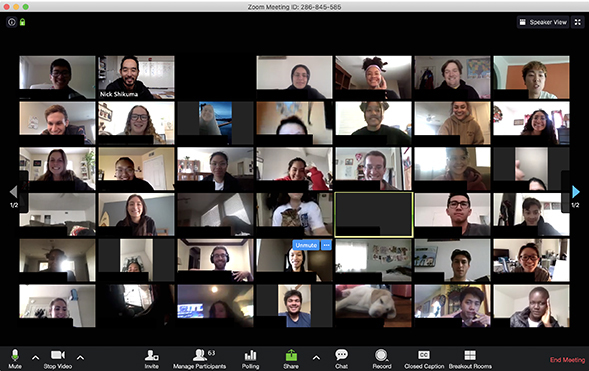
The rapid transition out of the classroom due to COVID-19 brought challenges and some bright spots.
By Padma Nagappan
This semester, San Diego State University professor Nick Shikuma teaches an upper level undergraduate microbiology course with 141 students, and a graduate research course with three students. But class size doesn’t necessarily correlate to the complexities involved.
Across the nation, students are adapting to online classes under shelter-in-place orders, and some are experiencing anxiety. Shikuma finds he is part counselor and part professor as he addresses those concerns.
“My graduate students are stressed about the impact this will have on their research,” Shikuma said. “Among my undergraduate students, some are seniors who are sad to leave their friends since this is their last semester in college, and I can relate to that.”
During online office hours in recent weeks, he’s received a lot of questions about these concerns too, not just questions relating to class material and grades.
“They’re also looking to me for guidance,” he said. “It’s a tough place to be for everyone.”
Shikuma himself has two young children. Working from home has been possible for him and his wife Erin Prahler, a senior planner with the California Coastal Commission, only because the children are being cared for by their grandmother who is visiting.
Aside from teaching, Shikuma runs a seven-member lab where he supervises researchers ranging from undergraduates to post-doctoral associates. Managing the transition for everyone has been hectic for him and many other faculty.
This semester, San Diego State University professor Nick Shikuma teaches an upper level undergraduate microbiology course with 141 students, and a graduate research course with three students. But class size doesn’t necessarily correlate to the complexities involved.
“They’re also looking to me for guidance,” he said. “It’s a tough place to be for everyone.”
Shikuma himself has two young children. Working from home has been possible for him and his wife Erin Prahler, a senior planner with the California Coastal Commission, only because the children are being cared for by their grandmother who is visiting.
Aside from teaching, Shikuma runs a seven-member lab where he supervises researchers ranging from undergraduates to post-doctoral associates. Managing the transition for everyone has been hectic for him and many other faculty.
Leveraging Apps for Flexibility
Before the pandemic brought sweeping changes, Shikuma had already been using Top Hat, which enables interactive online learning, to gauge how much his students understood during his lectures. He had students install the app on their devices and gave them multiple choice questions they answered in real time. As his lecture progressed, he would track their responses and often observed that they shifted their choice as their understanding evolved over the course of the lecture.
Now, he has tapped the program to act as a stand-in proctor for online exams. For a recent exam before spring break, he provided questions that were only available for a certain length of time on the app, and combined it with Zoom to observe students.
The Top Hat program offers flexibility, which is needed at this time. When students had technical difficulties and reached out to Shikuma, he was able to reopen the relevant portion of the exam so they could retake the questions.
“This was my first time ever giving them an online exam,” Shikuma said. “I probably got 30 emails directly after the exam from students asking questions, because of unstable internet connections, and because they were still getting used to the interface, so they were nervous.”
Like many other faculty members on campus who are making accommodations, he was lenient and gave students extra time.
Not all aspects of learning can be covered through technology, however. His undergraduate course contains a lab component. The solution: He and his teaching assistants found online videos of experiments similar to what would have been conducted in the lab class, and they have students watch it and write it up.
“But they’re not going to get the hands-on training, which is unfortunate,” Shikuma said.
More Efficient Office Hours
However, along with the challenges, like other faculty, he has also discovered some benefits to virtual instruction.
Shikuma has found that online office hours have been much more productive compared to holding office hours on campus.
“Before, students would come in one at a time and I would often answer the same questions over and over,” he said. “Now, I record my office hours and address common questions, and they’re all able to listen in, and those who don’t log in during the actual time can check in later. I can also refer to slides while I discuss questions. So I might actually continue doing office hours on Zoom in the future.”